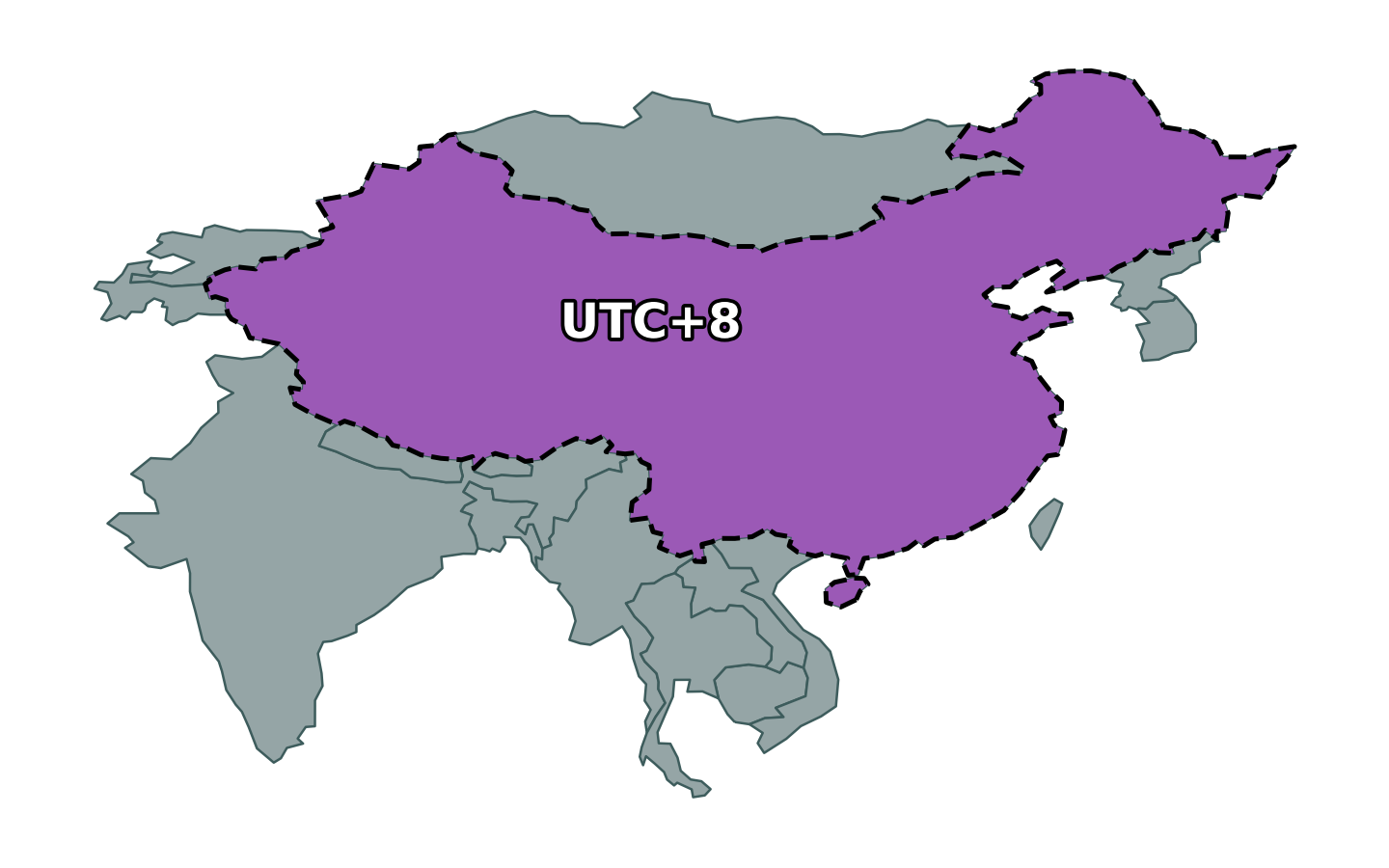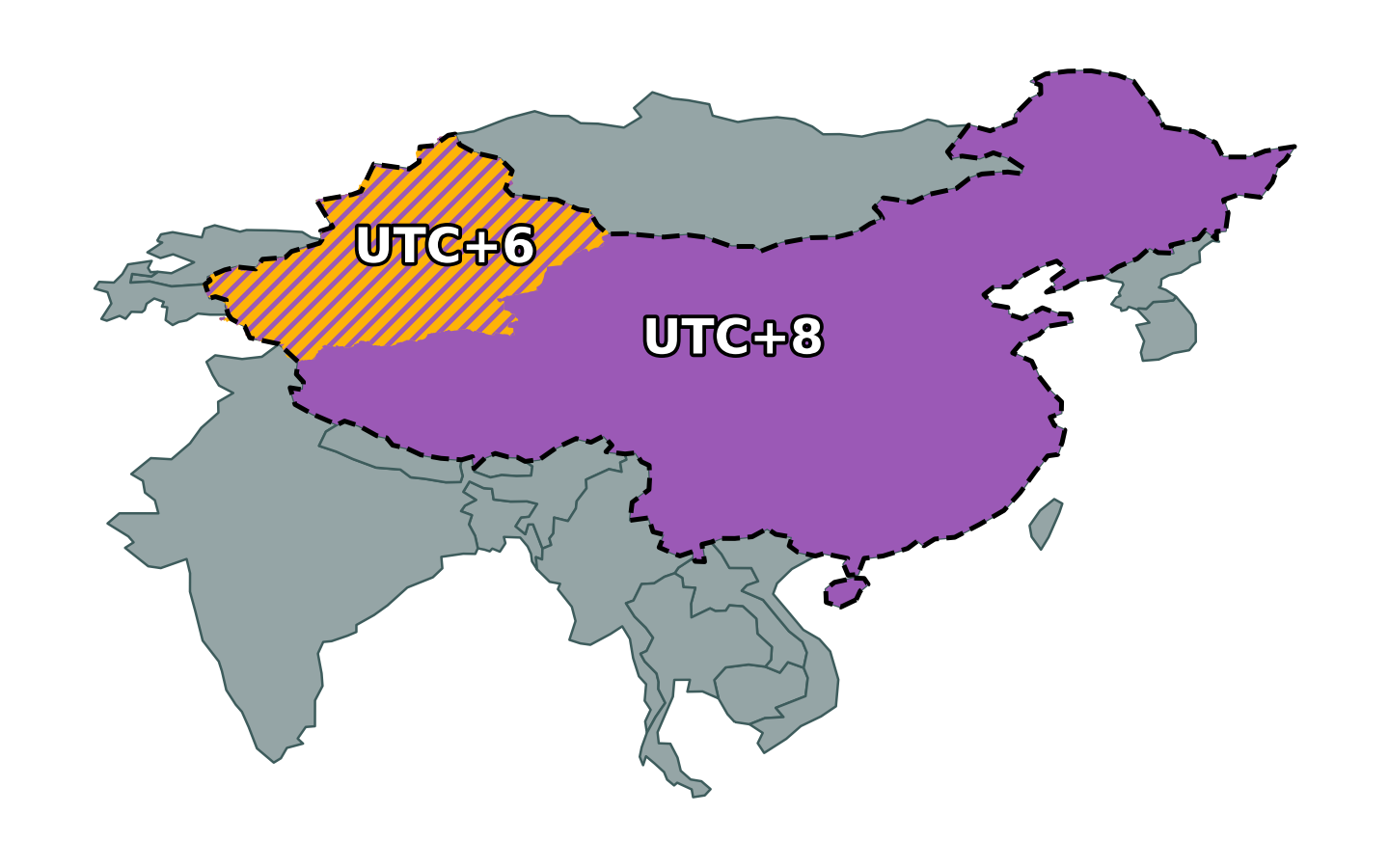Paul Ganssle

Introduction¶
UTC¶
- Reference time zone
- Monotonic-ish (what's a few leap seconds between friends?)
Time zones vs. Offsets¶
UTC+1is an offsetEurope/Londonis a time zone
BSTis a highly-context-dependent abbreviation:- British Summer Time (
UTC+1) - Bangladesh Standard Time (
UTC+6) - Bougainville Standard Time (
UTC+11)
- British Summer Time (
Complicated time zones¶
Non-integer offsets¶
Examples:
Australia/Adelaide(+09:30)Asia/Kathmandu(+05:45)Africa/Monrovia(+00:44:30) (Before 1979)
Change of DST status without offset change¶
Portugal, 1992
WET (+0 STD) -> WEST (+1 DST) 1992-03-29WEST (+1 DST) -> CET (+1 STD) 1992-09-27
Portugal, 1996
CET (+1 STD) -> WEST (+1 DST) 1996-03-31WEST (+1 DST) -> WET (+0 STD) 1996-10-27
Complicated time zones¶
More than one DST transition per year¶
- Morroco, 2012
WET (+0 STD) -> WEST (+1 DST) 2012-04-29WEST (+1 DST) -> WET (+0 STD) 2012-07-20WET (+0 STD) -> WEST (+1 DST) 2012-08-20WEST (+1 DST) -> WET (+0 STD) 2012-09-30
... and Morocco in 2013-present, and Egypt in 2010 and 2014, and Palestine in 2011.
Complicated time zones¶
Missing days¶
- Christmas Island (Kiritimati), December 31, 1994 (UTC-10 -> UTC+14)
dt_before = datetime(1994, 12, 30, 23, 59, tzinfo=tz.gettz('Pacific/Kiritimati'))
dt_after = add_absolute(dt_before, timedelta(minutes=2))
print(dt_before)
print(dt_after)
1994-12-30 23:59:00-10:00 1995-01-01 00:01:00+14:00
Also Samoa on January 29, 2011.
Complicated time zones¶
Double days¶
- Kwajalein Atoll, 1969
dt_before = datetime(1969, 9, 30, 11, 59, tzinfo=tz.gettz('Pacific/Kwajalein'))
dt_after = add_absolute(dt_before, timedelta(minutes=2))
print(dt_before)
print(dt_after)
1969-09-30 11:59:00+11:00 1969-09-30 12:01:00+11:00
Asia/Shanghai¶

Asia/Urumqi¶

Why do we need to work with time zones at all?¶
from dateutil import rrule as rr
# Close of business in New York on weekdays
closing_times = rr.rrule(freq=rr.DAILY, byweekday=(rr.MO, rr.TU, rr.WE, rr.TH, rr.FR),
byhour=17, dtstart=datetime(2017, 3, 9, 17), count=5)
for dt in closing_times:
print(dt.replace(tzinfo=NYC))
2017-03-09 17:00:00-05:00 2017-03-10 17:00:00-05:00 2017-03-13 17:00:00-04:00 2017-03-14 17:00:00-04:00 2017-03-15 17:00:00-04:00
for dt in closing_times:
print(dt.replace(tzinfo=NYC).astimezone(UTC))
2017-03-09 22:00:00+00:00 2017-03-10 22:00:00+00:00 2017-03-13 21:00:00+00:00 2017-03-14 21:00:00+00:00 2017-03-15 21:00:00+00:00
Python's Time Zone Model¶
tzinfo¶
- Time zones are provided by subclassing
tzinfo. Information provided is a function of the datetime:
tzname: The (usually abbreviated) name of the time zone at the given datetimeutcoffset: The offset from UTC at the given datetimedst: The size of the datetime's DST offset (usually 0 or 1 hour)
An example tzinfo implementation¶
class ET(tzinfo):
def utcoffset(self, dt):
if self.isdaylight(dt):
return timedelta(hours=-4)
else:
return timedelta(hours=-5)
def dst(self, dt):
if self.isdaylight(dt):
return timedelta(hours=1)
else:
return timedelta(hours=0)
def tzname(self, dt):
return "EDT" if self.isdaylight(dt) else "EST"
def isdaylight(self, dt):
dst_start = datetime(dt.year, 1, 1) + rd.relativedelta(month=3, weekday=rd.SU(+2),
hour=2)
dst_end = datetime(dt.year, 1, 1) + rd.relativedelta(month=11, weekday=rd.SU,
hour=2)
return dst_start <= dt.replace(tzinfo=None) < dst_end
An example tzinfo implementation¶
EASTERN = ET()
print(datetime(2017, 11, 4, 12, 0, tzinfo=EASTERN))
print(datetime(2017, 11, 5, 12, 0, tzinfo=EASTERN))
2017-11-04 12:00:00-04:00 2017-11-05 12:00:00-05:00
dt_before_utc = datetime(2017, 11, 5, 0, 30, tzinfo=EASTERN).astimezone(tz.UTC)
dt_during = (dt_before_utc + timedelta(hours=1)).astimezone(EASTERN) # 1:30 EDT
dt_after = (dt_before_utc + timedelta(hours=2)).astimezone(EASTERN) # 1:30 EST
print(dt_during) # Lookin good!
print(dt_after) # OH NO!
2017-11-05 01:30:00-04:00 2017-11-05 02:30:00-05:00
Ambiguous times¶
Ambiguous times are times where the same "wall time" occurs twice, such as during a DST to STD transition.
dt1 = datetime(2004, 10, 31, 4, 30, tzinfo=UTC)
for i in range(4):
dt = (dt1 + timedelta(hours=i)).astimezone(NYC)
print('{} | {} | {}'.format(dt, dt.tzname(),
'Ambiguous' if tz.datetime_ambiguous(dt)
else 'Unambiguous'))
2004-10-31 00:30:00-04:00 | EDT | Unambiguous 2004-10-31 01:30:00-04:00 | EDT | Ambiguous 2004-10-31 01:30:00-05:00 | EST | Ambiguous 2004-10-31 02:30:00-05:00 | EST | Unambiguous
PEP-495: Local Time Disambiguation¶
- First introduced in Python 3.6
- Introduces the
foldattribute ofdatetime - Changes to aware datetime comparison around ambiguous times
Whether you are on the fold side is a property of the datetime:
print_tzinfo(datetime(2004, 10, 31, 1, 30, tzinfo=NYC)) # fold=0
print_tzinfo(datetime(2004, 10, 31, 1, 30, fold=1, tzinfo=NYC))
2004-10-31 01:30:00-0400
tzname: EDT; UTC Offset: -4.00h; DST: 1.0h
2004-10-31 01:30:00-0500
tzname: EST; UTC Offset: -5.00h; DST: 0.0h
Note: fold=1 represents the second instance of an ambiguous datetime
Comparing timezone-aware datetimes: Same Zone¶
In the same zone, wall clock times are used, offset ignored
print_dt_eq(dt1.replace(tzinfo=NYC), dt2.replace(tzinfo=NYC)) # Unambiguous
print_dt_eq(dt1.replace(tzinfo=NYC), dt3.replace(tzinfo=NYC))
print_dt_eq(dt1a.replace(tzinfo=NYC), dt2a.replace(tzinfo=NYC)) # Ambiguous
print_dt_eq(dt1a.replace(tzinfo=NYC), dt2a.replace(fold=1, tzinfo=NYC), bold=True)
print_dt_eq(dt1a.replace(tzinfo=NYC), dt3a.replace(tzinfo=NYC))
Comparing timezone-aware datetimes: Different Zones¶
If both datetimes are unambiguous, the absolute times are compared:
print_dt_eq(dt1.replace(tzinfo=NYC), dt2.replace(tzinfo=CHI)) # Unambiguous
print_dt_eq(dt1.replace(tzinfo=NYC), dt3.replace(tzinfo=CHI))
If either datetime is ambiguous, the result is always False:
print_dt_eq(dt1a.replace(fold=1, tzinfo=NYC), dt3a.replace(tzinfo=CHI), bold=True)
A curious case...¶
LON = gettz('Europe/London')
x = datetime(2007, 3, 25, 1, 0, tzinfo=LON)
ts = x.timestamp()
y = datetime.fromtimestamp(ts, LON)
z = datetime.fromtimestamp(ts, gettz.nocache('Europe/London'))
x == y
False
x == z
True
y == z
True
Imaginary Times¶
Imaginary times are wall times that don't exist in a given time zone, such as during an STD to DST transition.
dt1 = datetime(2004, 4, 4, 6, 30, tzinfo=UTC)
for i in range(3):
dt = (dt1 + timedelta(hours=i)).astimezone(NYC)
print(f'{dt} | {dt.tzname()} ')
2004-04-04 01:30:00-05:00 | EST 2004-04-04 03:30:00-04:00 | EDT 2004-04-04 04:30:00-04:00 | EDT
print(datetime(2007, 3, 25, 1, 0, tzinfo=LON))
2007-03-25 01:00:00+01:00
print(datetime(2007, 3, 25, 0, 0, tzinfo=UTC).astimezone(LON))
print(datetime(2007, 3, 25, 1, 0, tzinfo=UTC).astimezone(LON))
2007-03-25 00:00:00+00:00 2007-03-25 02:00:00+01:00
Why it was non-transitive¶
print(f'x (LON): {x}')
print(f'x (UTC): {x.astimezone(UTC)}')
print(f'x (LON->UTC->LON): {x.astimezone(UTC).astimezone(LON)}')
x (LON): 2007-03-25 01:00:00+01:00 x (UTC): 2007-03-25 00:00:00+00:00 x (LON->UTC->LON): 2007-03-25 00:00:00+00:00
print(f'y: {y}')
print(f'z: {z}')
y: 2007-03-25 00:00:00+00:00 z: 2007-03-25 00:00:00+00:00
x.tzinfo is y.tzinfo
True
x.tzinfo is z.tzinfo
False
Working with time zones¶
dateutil¶
In dateutil's suite of tzinfo objects, you can attach time zones in the constructor if you have a wall time:
dt = datetime(2017, 8, 11, 14, tzinfo=tz.gettz('US/Pacific'))
print_tzinfo(dt)
2017-08-11 14:00:00-0700
tzname: PDT; UTC Offset: -7.00h; DST: 1.0h
If you have a naive wall time, or a wall time in another zone that you want to translate without shifting the offset, use datetime.replace:
print_tzinfo(dt.replace(tzinfo=tz.gettz('US/Eastern')))
2017-08-11 14:00:00-0400
tzname: EDT; UTC Offset: -4.00h; DST: 1.0h
If you have an absolute time, in UTC or otherwise, use datetime.astimezone():
print_tzinfo(dt.astimezone(tz.gettz('US/Eastern')))
2017-08-11 17:00:00-0400
tzname: EDT; UTC Offset: -4.00h; DST: 1.0h
pytz¶
In pytz, datetime.astimezone() still works exactly as expected:
print_tzinfo(dt.astimezone(pytz.timezone('US/Eastern')))
2017-08-11 17:00:00-0400
tzname: EDT; UTC Offset: -4.00h; DST: 1.0h
But the constructor or .replace methods fail horribly:
print_tzinfo(dt.replace(tzinfo=pytz.timezone('US/Eastern')))
2017-08-11 14:00:00-0456
tzname: LMT; UTC Offset: -4.93h; DST: 0.0h
pytz's time zone model¶
tzinfos are all static offsetstzinfois attached by the time zone object itself:
LOS_p = pytz.timezone('America/Los_Angeles')
dt = LOS_p.localize(datetime(2017, 8, 11, 14, 0))
print_tzinfo(dt)
2017-08-11 14:00:00-0700
tzname: PDT; UTC Offset: -7.00h; DST: 1.0h
- You must
normalize()datetimes after you've done some arithmetic on them:
dt_add = dt + timedelta(days=180)
print_tzinfo(dt_add)
2018-02-07 14:00:00-0700
tzname: PDT; UTC Offset: -7.00h; DST: 1.0h
print_tzinfo(LOS_p.normalize(dt_add))
2018-02-07 13:00:00-0800
tzname: PST; UTC Offset: -8.00h; DST: 0.0h
There is more detail on this on my blog post, "pytz: The Fastest Footgun in the West" (https://blog.ganssle.io/articles/2018/03/pytz-fastest-footgun.html)
Handling ambiguous times¶
Overview¶
Both dateutil and pytz will automatically give you the right absolute time if converting from an absolute time.
dt1 = datetime(2004, 10, 31, 6, 30, tzinfo=UTC) # This is in the fold in EST
dt_dateutil = dt1.astimezone(tz.gettz('US/Eastern'))
dt_pytz = dt1.astimezone(pytz.timezone('US/Eastern'))
print(repr(dt_dateutil))
print_tzinfo(dt_dateutil)
datetime.datetime(2004, 10, 31, 1, 30, fold=1, tzinfo=tzfile('/usr/share/zoneinfo/US/Eastern'))
2004-10-31 01:30:00-0500
tzname: EST; UTC Offset: -5.00h; DST: 0.0h
print(repr(dt_pytz)) # Note that pytz doesn't set fold
print_tzinfo(dt_pytz)
datetime.datetime(2004, 10, 31, 1, 30, tzinfo=<DstTzInfo 'US/Eastern' EST-1 day, 19:00:00 STD>)
2004-10-31 01:30:00-0500
tzname: EST; UTC Offset: -5.00h; DST: 0.0h
dateutil¶
For backwards compatibility, dateutil provides a tz.enfold method to add a fold attribute if necessary:
dt = datetime(2004, 10, 31, 1, 30, tzinfo=tz.gettz('US/Eastern'))
tz.enfold(dt)
datetime.datetime(2004, 10, 31, 1, 30, fold=1, tzinfo=tzfile('/usr/share/zoneinfo/US/Eastern'))
Python 2.7.12
Type "help", "copyright", "credits" or "license" for more information.
>>> from datetime import datetime
>>> from dateutil import tz
>>> dt = datetime(2004, 10, 31, 1, 30, tzinfo=tz.gettz('US/Eastern'))
>>> tz.enfold(dt)
_DatetimeWithFold(2004, 10, 31, 1, 30, tzinfo=tzfile('/usr/share/zoneinfo/US/Eastern'))
>>> tz.enfold(dt).tzname()
'EST'
>>> dt.tzname()
'EDT'
dateutil¶
To detect ambiguous times, dateutil provides tz.datetime_ambiguous
tz.datetime_ambiguous(datetime(2004, 10, 31, 1, 30, tzinfo=NYC))
True
dt_0 = datetime(2004, 10, 31, 0, 30, tzinfo=NYC)
for i in range(3):
dt_i = dt_0 + timedelta(hours=i)
dt_i = tz.enfold(dt_i, tz.datetime_ambiguous(dt_i))
print(f'{dt_i} (fold={dt_i.fold})')
2004-10-31 00:30:00-04:00 (fold=0) 2004-10-31 01:30:00-05:00 (fold=1) 2004-10-31 02:30:00-05:00 (fold=0)
Note: fold is ignored when the datetime is not ambiguous:
for i in range(3):
dt_i = tz.enfold(dt_0 + timedelta(hours=i), fold=1)
print(f'{dt_i} (fold={dt_i.fold})')
2004-10-31 00:30:00-04:00 (fold=1) 2004-10-31 01:30:00-05:00 (fold=1) 2004-10-31 02:30:00-05:00 (fold=1)
Handling imaginary times¶
dateutil¶
dateutil provides a tz.datetime_exists() function to tell you whether you've constructed an imaginary datetime:
dt_0 = datetime(2004, 4, 4, 1, 30, tzinfo=NYC)
for i in range(3):
dt = dt_0 + timedelta(hours=i)
print(f'{dt} ({{}})'.format('Exists' if tz.datetime_exists(dt) else 'Imaginary'))
2004-04-04 01:30:00-05:00 (Exists) 2004-04-04 02:30:00-04:00 (Imaginary) 2004-04-04 03:30:00-04:00 (Exists)
tz.resolve_imaginary¶
Generally for imaginary datetimes, you want to "skip forward" to what the the time would be if the transition had not happened. In dateutil you can use the tz.resolve_imaginary function to do this automatically:
dt = datetime(2004, 4, 4, 1, 30, tzinfo=NYC)
dt_imag = dt + timedelta(hours=1)
print(tz.resolve_imaginary(dt_imag))
2004-04-04 03:30:00-04:00
dt = datetime(1994, 12, 31, 9, tzinfo=tz.gettz('Pacific/Kiritimati'))
print(f'{dt} ({{}})'.format('Exists' if tz.datetime_exists(dt) else 'Imaginary'))
1994-12-31 09:00:00-10:00 (Imaginary)
tz.resolve_imaginary(dt)
datetime.datetime(1995, 1, 1, 9, 0, tzinfo=tzfile('/usr/share/zoneinfo/Pacific/Kiritimati'))
Both of these functions work with pytz time zones as well.
dateutil's tzinfo implementations¶
UTC and Static time zones¶
# tz.UTC is equivalent to pytz.UTC or timezone.utc
dt = datetime(2014, 12, 19, 22, 30, tzinfo=tz.UTC)
print_tzinfo(dt)
2014-12-19 22:30:00+0000
tzname: UTC; UTC Offset: 0.00h; DST: 0.0h
Static offsets represent zones with a fixed offset from UTC, and takes a tzname or either number of seconds or a timedelta:
JST = tzoffset('JST', 32400) # Japan Standard Time is year round
EST = tzoffset(None, timedelta(hours=-5)) # Can use None as a name
dt = datetime(2016, 7, 17, 12, 15, tzinfo=tz.UTC)
print_tzinfo(dt.astimezone(JST))
print_tzinfo(dt.astimezone(EST))
2016-07-17 21:15:00+0900
tzname: JST; UTC Offset: 9.00h; DST: 0.0h
2016-07-17 07:15:00-0500
tzname: None; UTC Offset: -5.00h; DST: 0.0h
IANA (Olson) database¶
The IANA database contains historical time zone transitions:
NYC = tz.gettz('America/New_York')
NYC
tzfile('/usr/share/zoneinfo/America/New_York')
print_tzinfo(datetime(2017, 8, 12, 14, tzinfo=NYC)) # Eastern Daylight Time
2017-08-12 14:00:00-0400
tzname: EDT; UTC Offset: -4.00h; DST: 1.0h
print_tzinfo(datetime(1944, 1, 6, 12, 15, tzinfo=NYC)) # Eastern War Time
1944-01-06 12:15:00-0400
tzname: EWT; UTC Offset: -4.00h; DST: 1.0h
print_tzinfo(datetime(1901, 9, 6, 16, 7, tzinfo=NYC)) # Local solar mean
1901-09-06 16:07:00-045602
tzname: LMT; UTC Offset: -4.93h; DST: 0.0h
tz.gettz()¶
The best way to get a time zone is to pass the relevant timezone string to the gettz() function, which is intended to be a Python equivalent to the TZ environment variable.
tz.gettz() # Passing nothing gives you local time
tzfile('/etc/localtime')
# If it finds a valid abbreviation for the local zone, returns tzlocal()
with TZEnvContext('LMT4'):
print(gettz('LMT'))
tzlocal()
# Retrieve IANA zone:
print(gettz('Pacific/Kiritimati'))
tzfile('/usr/share/zoneinfo/Pacific/Kiritimati')
Timezone Tips¶
Civil time vs. Timestamp¶
- Civil times are "wall times" - use this when it matters what the clock on the wall says (e.g. meetings, television shows)
- Timestamps are specific moments in time: use this when it matters what order things happened in or the duration between two events (e.g. logging, astronomical events)
Store civil times as naive portion + time zone serialization (e.g. America/New_York). Store timestamps in UTC or equivalent.
IANA and CDR¶
- Never rely on a 3-letter abbreviation.
- IANA keys are lookups in the tz database
- Use Unicode CLDR (Common Locale Data Repository) to get display names for time zones
Thank You!¶
dateutil¶
If you're interested in helping out with dateutil development, check out the issues on the github or e-mail me.
Open Issues - https://github.com/dateutil/dateutil - Check out the help wanted label!¶
Me¶
GPG Key¶
6B49 ACBA DCF6 BD1C A206 67AB CD54 FCE3 D964 BEFB